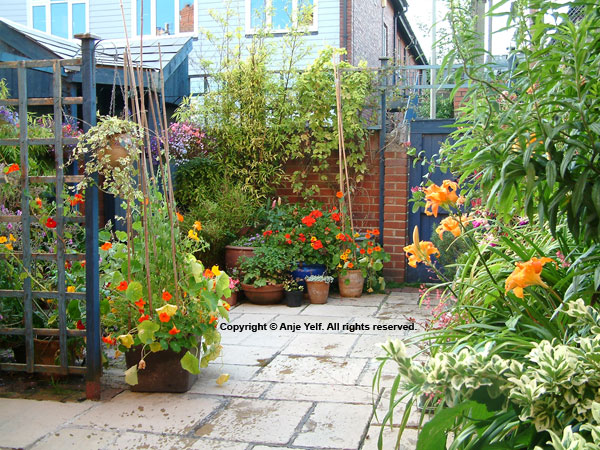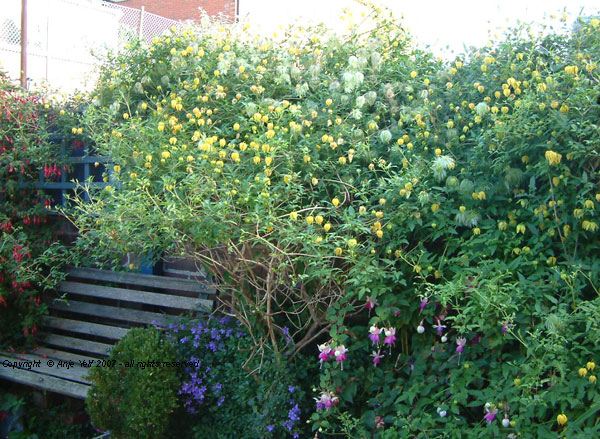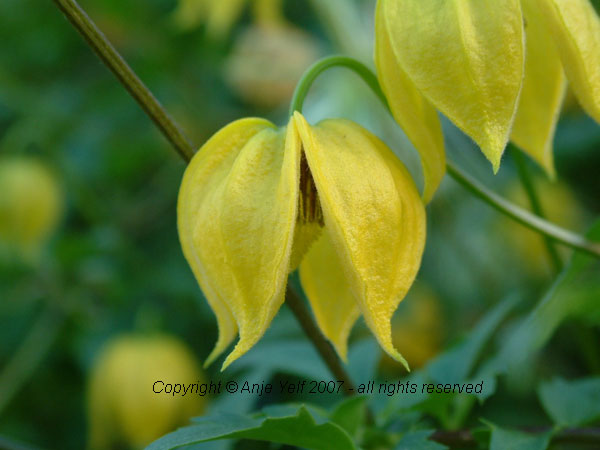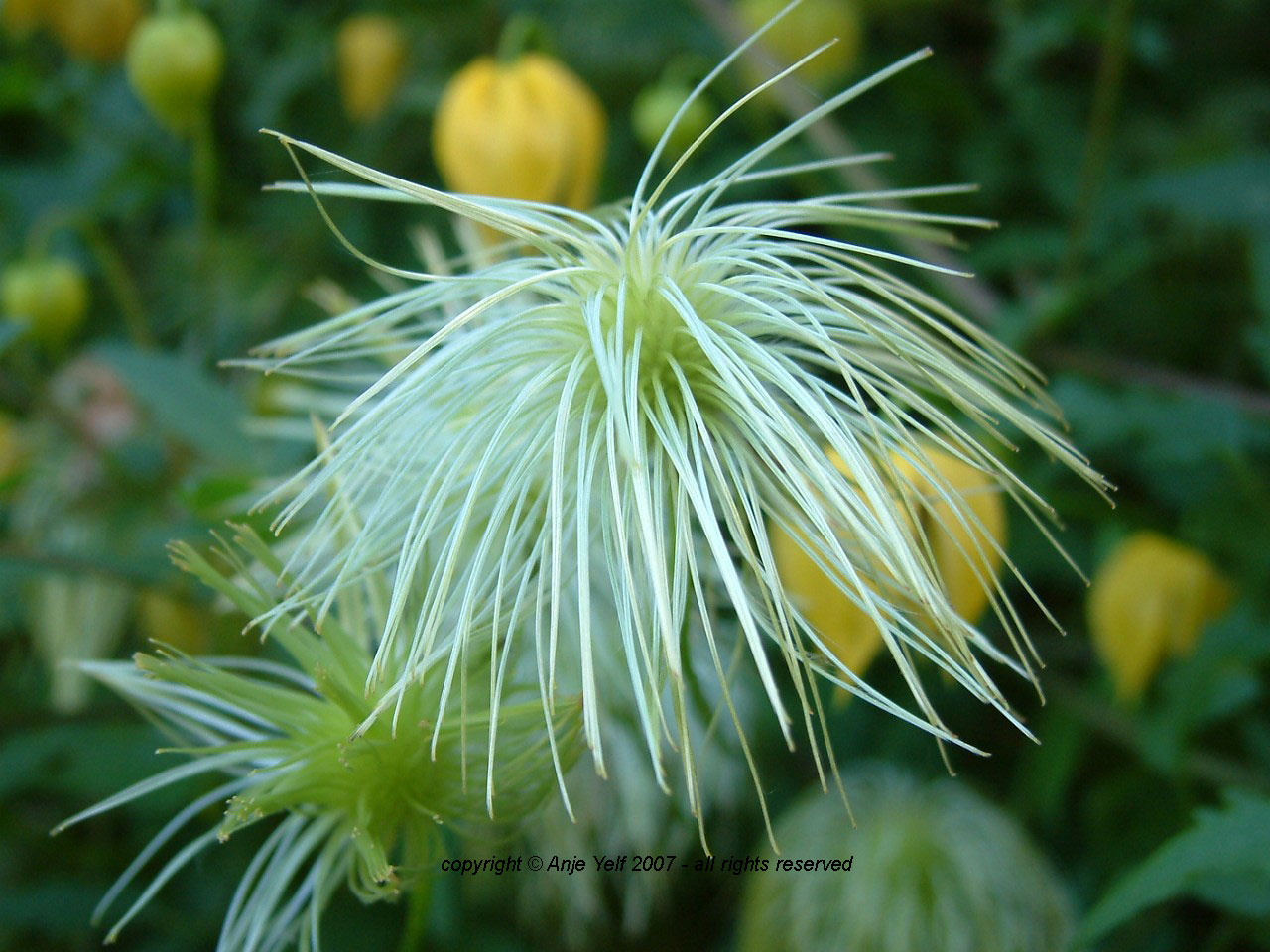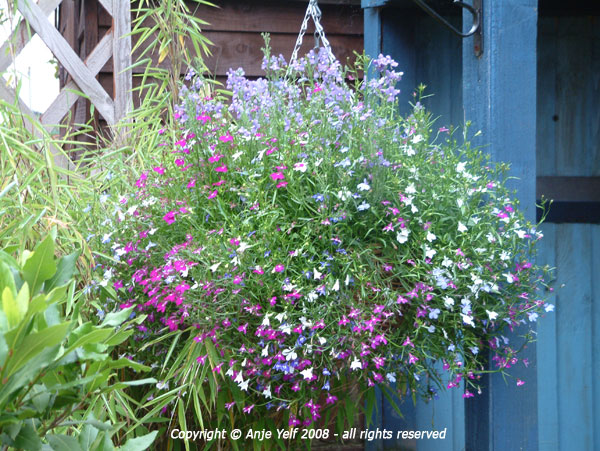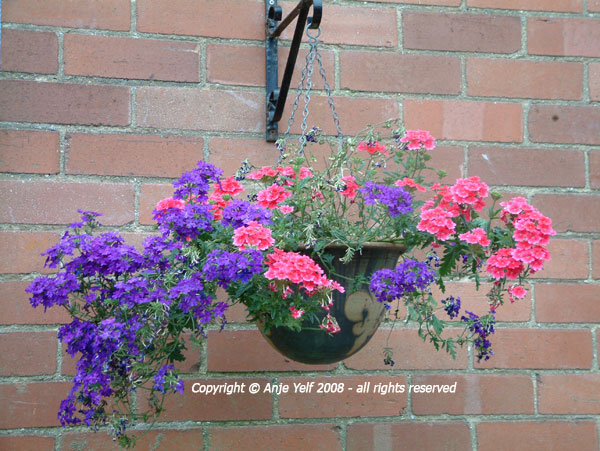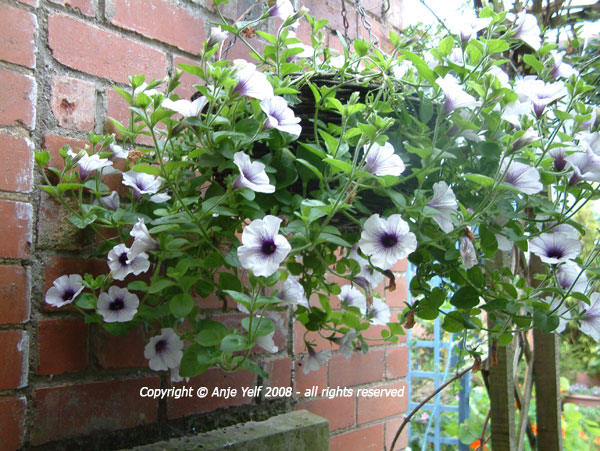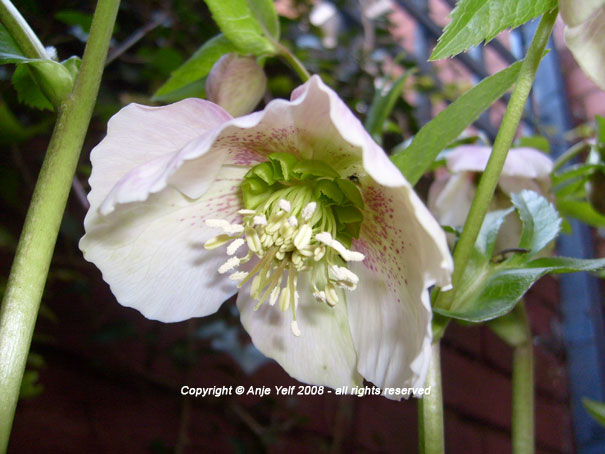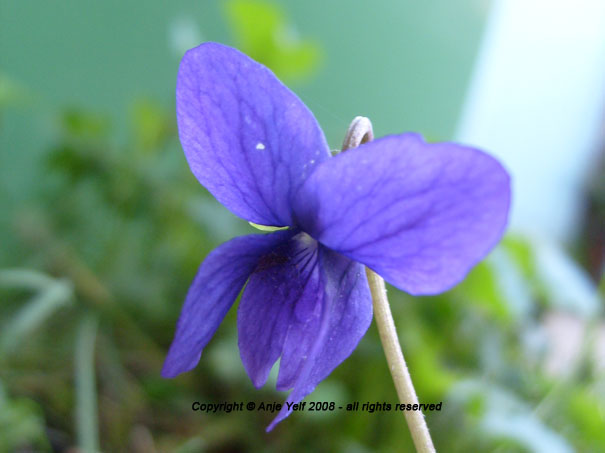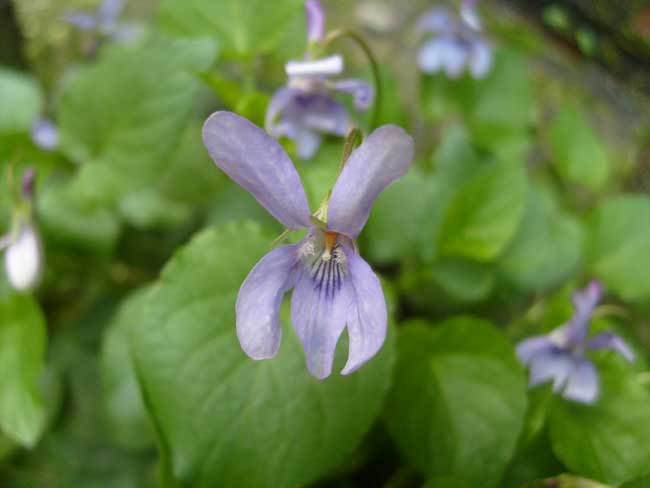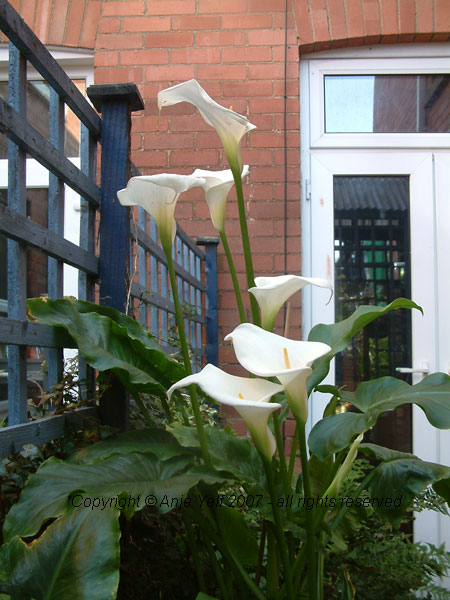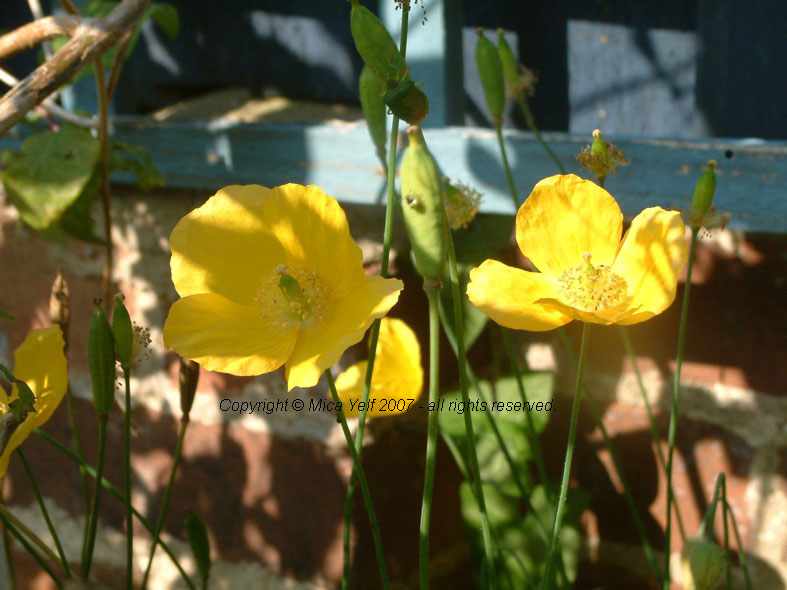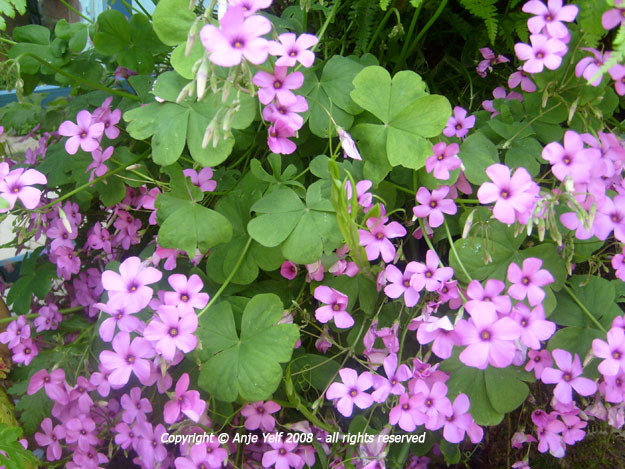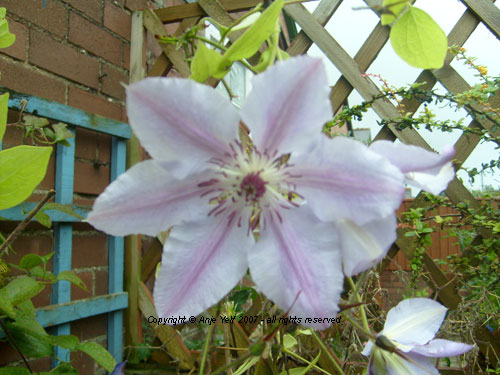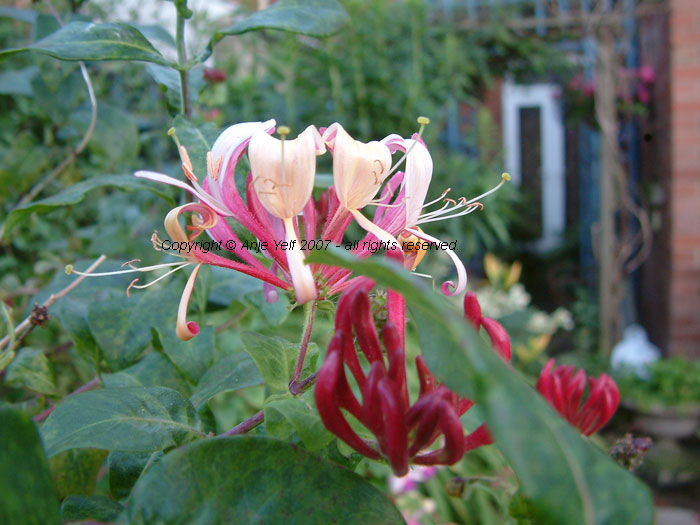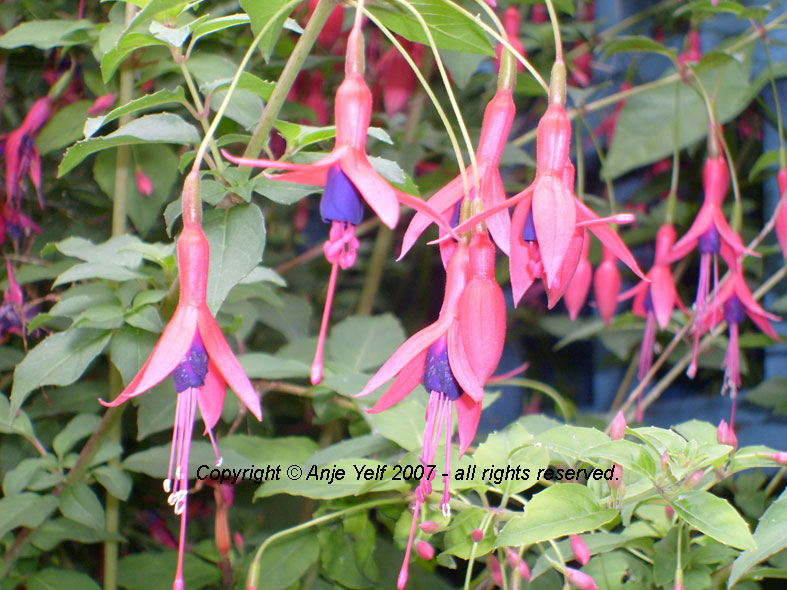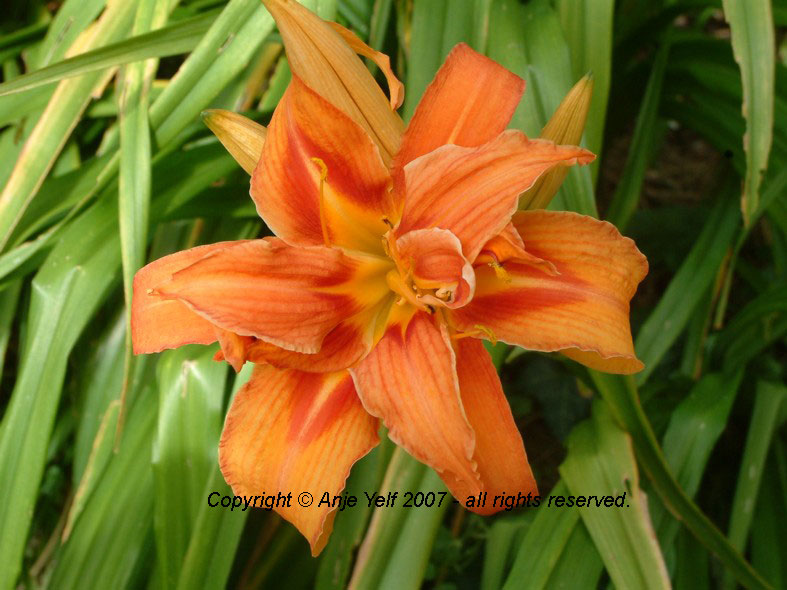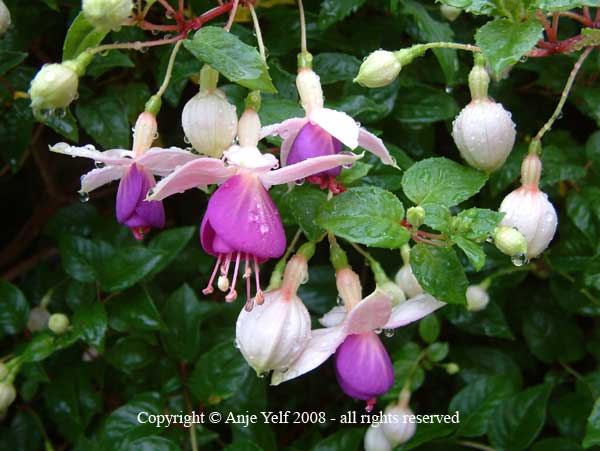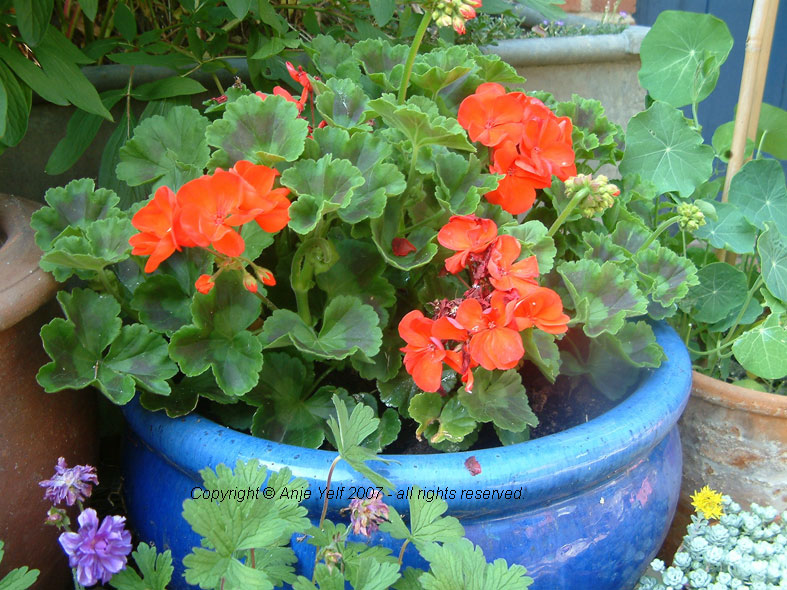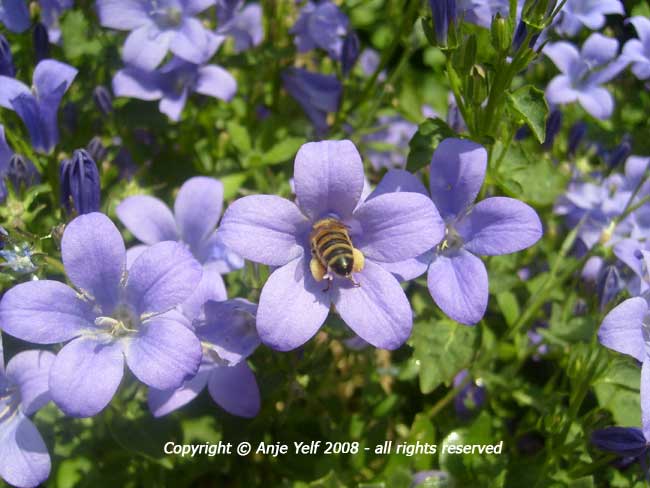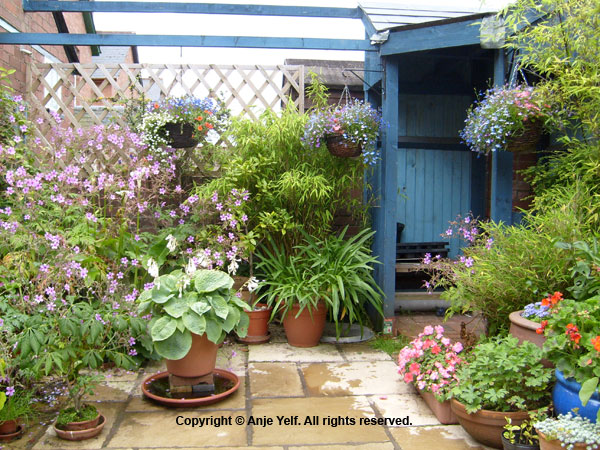My Edwardian Townhouse Courtyard Garden
Planting Design | Colours for North Facing GardensTall flowering Plants | Hanging Baskets | Plants for Variety
Garden Layout

The brick-walled rear courtyard garden of our Edwardian mid-terraced home faces due north and therefore limited in the amount of area receiving direct sunshine. The eastern side is about 44 feet long, but half the length is in permanent shade. At the narrow end, french windows allow access to the garden.
The main area (18' x 22') is paved in a cotswold style. Along the eastern side is a bank of earth held in place by dry stone walls. The northern and western walls are lined with various containers and pots; neat plant container idea - try galvanised pig troughs.
The blue rectangular shape was the old pantry and outside loo, but is now the potting shed. In the north-west corner, my husband created a corner gazebo; perfect for enjoying the sunrise with a mug of tea. Against the potting shed, a water feature has been created from two old belfast sinks covered in a concrete and peat mix, then sealed on the inner side.
Planting Design
This small back yard is host to differing climatic conditions, which can change within a matter of feet. This presents an interesting and sometimes frustrating situation, which emphasises the importance on choosing the right plant for the right place in the garden.
The size and aspect of the courtyard garden places constraints on the general size of planting. Most of the planting is in containers, however some of the containers are generous. It is important to understand that small gardens do not necessarily mean you must only use small plants. I have used bamboos and climbers to create vertical planting and provide some privacy. In addition, pots, planters and hanging baskets can contain different composts to suit different plants that many not normally like the natural garden soil in your area.
Foliage is important. No matter the size of your garden, consider using plants with: large leaves, rounded, cut leaf and delicate filigree forms. Colour can be used to great effect. The red and bronze of heuchera cherry cola can make a focal point for a well placed plant.
Colours for North Facing Gardens
The courtyard wall was built using a warm red brick in keeping with the same bricks used at the back of the house. Strong shadows contrast the sunlight areas and pale colours struggle to find their place, but vibrant hues of red, yellow, orange and blue tempered with white, warm the garden with their richness and attract a diversity of insect life.
A garden that has a significant amount of shade can appear more vibrant if you use colours that are more intense and contrasting. Shadow contains alot of natural blue light and you can use this to your advantage by choosing blue stains and paint for woodwork. All the woodwork in my garden has been stained with cuprinol Forget-Me-Not (light blue) and Iris (dark blue) for wood. Even in poor light, the blue is enhanced.
This image of the courtyard garden is looking to the north and shows the view I see when
I walk out of my kitchen door and look down the garden.
Tall Flowering Plants
To improve privacy and gain extra height I have used:
- 12 feet high bamboos, contained in large pots to retrict spread of growth.
- climber Golden Hop, which like full sun so they are on the South facing wall. They like to be well fed with compost or manure. Comma Butterflies really love this plant, so don't be surprised to see their caterpillars in summer.
- climber Clematis Nelly Moser, a plant that flowers twice a year and grows to about 10 feet, which can tolerate semi shade.
- climber Clematis Tangutica, a vigourous plant that can be cut to only 18 inches every early spring and still produce 16 feet
growth. Produces hundreds of small yellow dangling bell shape flowers that turn into fabulous seed heads, which appear quite exquiste
in a winter frost. Keep its roots in the shade and the flowers in the sun, perfect for the east wall.
Clematis Tangutica - flowering from August to November
Plant
Flower
Seedhead
- Honeysuckle Lonicera America provides wonderful scent in the summer months and after the flowers have gone, red berries complete the display.
- Wild Sweet Pea, planted in a large pot with fern and pink oxalis, climbs over 6ft using a free standing trellis for support and prolifically flowers. Dead head on a regular basis to extend flowering season and cut back before new growth in spring. Mine has been growing for decades and produces a fabulous display every year flowering until October.
- Ligularia Przewalskii commonly known as 'The Rocket'. An impressive plant all year. Two feet tall spikes of yellow flowers on black stems and large jagged green leaves with purple-red veins and edges. A sculpural plant that requires damp and shady conditions. Tip: The plant pot sits in a low trough of water with the arum lilies. Only the tall spires reach some sunlight.
Hanging Baskets
In constant sunlight:
The Lobelia (String of Pearls or any mixed variety) and Nemesia's are a great success. I have a pair hanging on either side of the gazebo entrance
In constant or mainly shade:
The red and blue verbena vibrate intense colour set against the red brickwork. They are in permanent shade against this north facing wall.
The basket of Blue veined Surfinia hangs outside my backdoor and receives only an hour (or two at the maximum) of sunlight a day. That's assuming the sun is shining - 2008 has been rather a 'grey' summer. The scent from this particular type of Surfinia is a delight every time I open the back door to the garden.
Sun |
Shade |
Shade |
Plants for Variety
There are a variety of plants that provide continual flowering or foliage interest throughout the year. Foxglove digitalis Excelcior is an excellent tall flowering statement plant for the back of the border and likes to grow where there is some shade. Another tall flowering favourite is the Arum Lily. I grow this plant for its huge leathery leaves and statueque flowers; I've planted it in two places, one in the permanent shade area towards the french windows and also on the west side in the corner by the Nelly Moser and Pink Oxalis, except this time I have kept its roots in a low level (3 inch) trough of water.
The full sun hot spot at the far north end of the garden is the perfect spot for my small pot of Sedum Spathulifolium. It flowers in the summer; intense yellow star-bursts on red stalks, but the small compact silver-grey rosettes of leaves add a sculptural effect all year round. This plant requires very little soil, but I have planted it in a tall pot using the dark blue glazed pot as a backdrop to show off the leaves and flower heads.
The rockery wall (which receives most of the sun after high noon) is smothered in Bellflower Campanular and a large pink flowering Heuchera; another purple leaved variety lives in a pot on the western side below a standard bay tree. Sweetpea, both the highly scented cultivated (in temporary pots mixed with Nasturtium) and the wild variety (growing from a large pot and spreading on a trellis) suit a sunnier aspect. There are several hanging baskets overflowing with Lobelia String of Pearls, Petunia Million Bells (Salsa and Crackling Fire) and Bacopa Snowflake. To add some scented flowers try Surfinia blue-veined variety, these plants are extremely tolerant of climatic conditions. I also have a large pot of Agapanthus the African Lily beside the covered sitting area, which like to be pot bound and kept in full sun.
Shade Tolerant Plants.
In the darkest section that extends up to the french windows, I have used a silver varigated Euonymus (Fortunei Emerald Gaiety), which lights up the sunless area along with Arum Lily, Lily of the Valley in small pots and a Hellebore which flowers in the winter. All of these plants sit comfortably with the ferns and a growing population of small woodland violets. I have two types of Violets growing in the courtyard. The woodland violet is a low, creeping perennial with heart-shaped dark green leaves and sweetly scented flowers. I also have some Dog Violets, which lack scent. They are easily identified by the fact that the sepals are sharply pointed in the dog violet and blunt (rounded) in the sweet. There are several ferns in the shaded areas, but one my favourites is the Japanese fern. The new fronds are red as they unfurl slowly changing to green as they mature.
Hellebore Niger |
Woodland Violet |
Dog Violet |
Arum Lily |
Welsh Poppy |
Pink Oxalis |
Clematis Nelly Moser |
The Pink Oxalis loves the shade, but it does get the morning sunlight. It has trifoliate, clover like leaves like a large shamrock. It is part of the sorrel family and so is an edible plant with a lemon refreshing sour taste. I'm gradually planting this around the edge of a galvanised pig trough in the dark corner facing north and west.
Honeysuckle |
Fuschsia Magellanica |
Nasturtium |
Day Lily |
Fuschsia Eva Boerg |
Pelagonium |
Agapanthus |
Campanula |
Peony |
Winter can also provide colour with Jasmin, Snowflakes and winter pansies.
As a bonus I have discovered that Busy Lizzies (impatiens) are versatile liking both the sunny and almost totally shaded areas.
There are many plants which I have not mentioned but I should say I do have a some pots devoted to herbs; chives (they have pretty pink balls of flowers on tall (6 inch) stalks, parsley, marjoram, rosemary, sage and bay. I keep a pot of basil in the kitchen window.
Finally, I had to have a Hosta. I chose the toughest, roughest beastie and gave it it's own large pot and set it in a large dish full of water to act as a moat. This I have found is the only way to stop the snails, but keep a careful watch on damp evenings after dark because I found some snails actually climb onto nearby plants and try to drop onto the Hosta and others will try to stretch across the moat! But I'm kind and just remove them to another section of the garden because there are slugs that eat the snails. Some years you discover a Toad who eat the slugs, worms etc. Now there's a couple of slow-worms doing a grand job to rmove slugs and invertibrates. So nature looks after itself.


